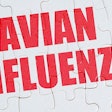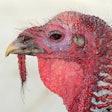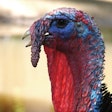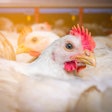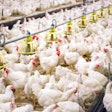
Avian influenza is becoming a global challenge and concern for the poultry sector, Rabobank Senior Analyst Nan-Kirk Mulder said during a presentation discussing the outlook for the global poultry industry at Merial's Global Avian Forum, held recently in Barcelona, Spain.
During his presentation, Mulder spoke to an audience of more than 500 people from 70 countries about the long-term market outlook for poultry production, as well as key investment themes and the strategic outlook of the industry.
Present outlook for the poultry industry
The global animal protein industry has benefited from lower feed prices until recent oversupply issues appeared. In the short term, there is an oversupply of corn and soybeans and feed prices look good.
In general, the market for meat keeps growing, although at a slower pace. Excluding China, chicken is forecast to grow at a 2.2 percent growth rate in 2016 and remains the most consumed meat. Pork will grow at 0.7 percent rate, beef at 0.4 percent and eggs at 2.1 percent.
China, where the trend is opposite, is the exception. In 2016, pork is estimated to grow at 1.5 percent, chicken at 1.6 percent, eggs at 0.4 percent and beef at 2.8 per cent. But things might also change there, because of food safety concerns and avian flu have a lot of impact in the Chinese market.
Mulder said that “avian influenza is becoming a global challenge and a global concern. It is a risk that the industry needs to handle in the coming years.”
The long-term outlook is positive. In the next 20 years, Mulder said there could be 65 percent more poultry demand and 50 percent more demand for eggs. 60 percent of the world’s protein demand will come from Asia. But, the question remains, where is production going to take place? Asia lacks the needed land resources.
Presently, available new agricultural land is located as follows: 45 percent in Sub-Saharan Africa, 10 percent in Brazil, 7 percent in Argentina and 11 percent in other Latin American countries. There is little left in the Northern hemisphere. Therefore, Mulder predicts Africa will be the future agricultural production area.
In terms of cost, Asian chicken production is 30 to 50 percent more expensive than Brazilian chicken production, without taking into account the health status of both regions. Therefore, Mulder emphasizes that “trade is going to be more important” than ever, but there are volatile global market conditions. As a matter of fact, this is already happening: Most trade goes to the Middle East, China, and Asia in general.
Analysts at Rabobank predict growth in poultry production for all the world regions. For Latin America, they forecast in 2016 Brazil will have a growth rate of 3.5 percent, Mexico 1.9 percent, Colombia 0.7 percent and Argentina 0.7 percent.
Investing in poultry production
If global incomes increase, so will food consumption, including poultry products. Therefore, investing in poultry consumption seem reasonable. However consumer concerns drive changes that move global industries, especially in developed economies. Issues like antibiotic-free (ABF) production and cage-free eggs are becoming more international. These consumer-driven changes are also spreading to emerging economies. So, are premium chickens a market opportunity? Possibly, in certain economies.
China is the most concrete example how big consumer concerns, such as with the cases of avian flu and safety, can affect the market. But Mulder says that “China will recover, but in another shape”. There is no doubt that, in any market, regaining confidence is the key.
In Asia, investors’ attention is moving away from China to elsewhere in Southeast Asia, to countries such as Indonesia, the Philippines, and even Myanmar. In Europe, eastern nations are growing, both in terms of local and export market growth. Poland is the fastest growing producer in Europe, growing at around 11 percent)
But once again, Mulder emphasized Sub-Saharan Africa as a region that is taking off. Economic growth is re-shaping the market.
“It is the new frontier in global poultry investments. Five years ago it was not like this. There is even a 10 percent growth in some parts. Supermarket chains, especially from South Africa are moving upwards”, Mulder said.
Impact of avian flu
To mitigate the avian flu risk, importers will have to be more dependent on a limited number of suppliers, but there will be more newcomers on the horizon. There are opportunities for countries such as the Ukraine, Argentina, and Russia for whole chickens, chicken breast and cuts.
Avian flu is changing breeding supply in terms of globalization of distribution and compartmentalization, and local programs to reduce import dependence.
The future
Looking ahead, Mulder said that many companies from emerging countries are making it into the top producers list. So, the outlook has changed. It is no longer only companies from developed nations.
The internationalization of the meat industry will continue. The poultry industry, in particular, is moving to Brazil, Thailand or even Russia, but will move forward to countries in Africa, or Indonesia and China.






